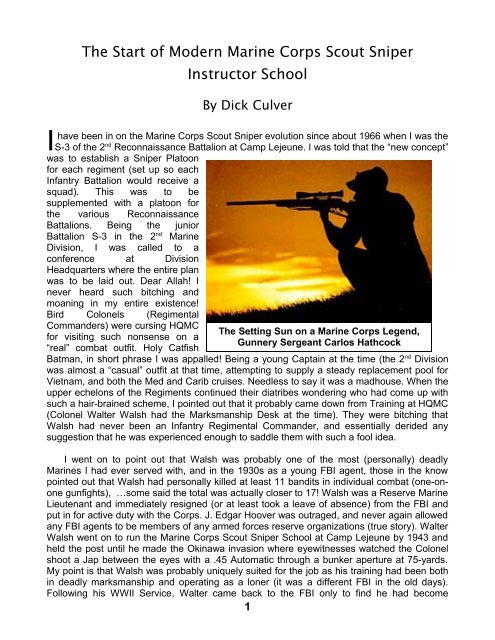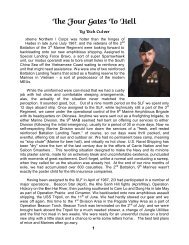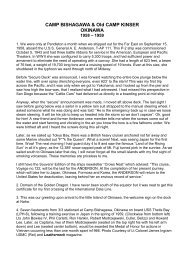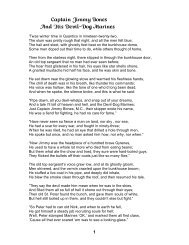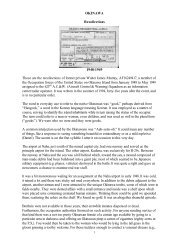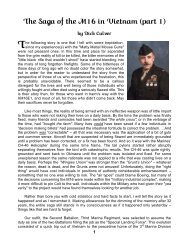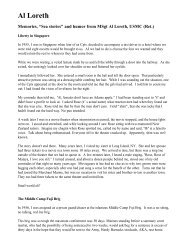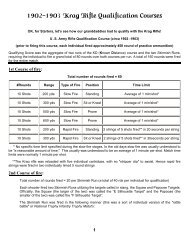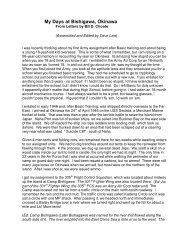History of the USMC Sniper School - Rohrer, Bob Rohrer
History of the USMC Sniper School - Rohrer, Bob Rohrer
History of the USMC Sniper School - Rohrer, Bob Rohrer
You also want an ePaper? Increase the reach of your titles
YUMPU automatically turns print PDFs into web optimized ePapers that Google loves.
I<br />
The Start <strong>of</strong> Modern Marine Corps Scout <strong>Sniper</strong><br />
Instructor <strong>School</strong><br />
By Dick Culver<br />
have been in on <strong>the</strong> Marine Corps Scout <strong>Sniper</strong> evolution since about 1966 when I was <strong>the</strong><br />
S-3 <strong>of</strong> <strong>the</strong> 2 nd Reconnaissance Battalion at Camp Lejeune. I was told that <strong>the</strong> “new concept”<br />
was to establish a <strong>Sniper</strong> Platoon<br />
for each regiment (set up so each<br />
Infantry Battalion would receive a<br />
squad). This was to be<br />
supplemented with a platoon for<br />
<strong>the</strong> various Reconnaissance<br />
Battalions. Being <strong>the</strong> junior<br />
Battalion S-3 in <strong>the</strong> 2 nd Marine<br />
Division, I was called to a<br />
conference at Division<br />
Headquarters where <strong>the</strong> entire plan<br />
was to be laid out. Dear Allah! I<br />
never heard such bitching and<br />
moaning in my entire existence!<br />
Bird Colonels (Regimental<br />
Commanders) were cursing HQMC<br />
The Setting Sun on a Marine Corps Legend,<br />
for visiting such nonsense on a<br />
Gunnery Sergeant Carlos Hathcock<br />
“real” combat outfit. Holy Catfish<br />
Batman, in short phrase I was appalled! Being a young Captain at <strong>the</strong> time (<strong>the</strong> 2 nd Division<br />
was almost a “casual” outfit at that time, attempting to supply a steady replacement pool for<br />
Vietnam, and both <strong>the</strong> Med and Carib cruises. Needless to say it was a madhouse. When <strong>the</strong><br />
upper echelons <strong>of</strong> <strong>the</strong> Regiments continued <strong>the</strong>ir diatribes wondering who had come up with<br />
such a hair-brained scheme, I pointed out that it probably came down from Training at HQMC<br />
(Colonel Walter Walsh had <strong>the</strong> Marksmanship Desk at <strong>the</strong> time). They were bitching that<br />
Walsh had never been an Infantry Regimental Commander, and essentially derided any<br />
suggestion that he was experienced enough to saddle <strong>the</strong>m with such a fool idea.<br />
I went on to point out that Walsh was probably one <strong>of</strong> <strong>the</strong> most (personally) deadly<br />
Marines I had ever served with, and in <strong>the</strong> 1930s as a young FBI agent, those in <strong>the</strong> know<br />
pointed out that Walsh had personally killed at least 11 bandits in individual combat (one-onone<br />
gunfights), …some said <strong>the</strong> total was actually closer to 17! Walsh was a Reserve Marine<br />
Lieutenant and immediately resigned (or at least took a leave <strong>of</strong> absence) from <strong>the</strong> FBI and<br />
put in for active duty with <strong>the</strong> Corps. J. Edgar Hoover was outraged, and never again allowed<br />
any FBI agents to be members <strong>of</strong> any armed forces reserve organizations (true story). Walter<br />
Walsh went on to run <strong>the</strong> Marine Corps Scout <strong>Sniper</strong> <strong>School</strong> at Camp Lejeune by 1943 and<br />
held <strong>the</strong> post until he made <strong>the</strong> Okinawa invasion where eyewitnesses watched <strong>the</strong> Colonel<br />
shoot a Jap between <strong>the</strong> eyes with a .45 Automatic through a bunker aperture at 75-yards.<br />
My point is that Walsh was probably uniquely suited for <strong>the</strong> job as his training had been both<br />
in deadly marksmanship and operating as a loner (it was a different FBI in <strong>the</strong> old days).<br />
Following his WWII Service, Walter came back to <strong>the</strong> FBI only to find he had become<br />
1
something <strong>of</strong> a pariah, and decided to return to <strong>the</strong> Marines, never to return to <strong>the</strong> FBI.<br />
Following his return to <strong>the</strong> Corps, Walsh became <strong>the</strong> guiding light <strong>of</strong> <strong>the</strong> Corps Marksmanship<br />
efforts until his retirement in <strong>the</strong> early 1970s. He was truly a legend in his own time.<br />
I was not well received at <strong>the</strong> “<strong>Sniper</strong> Conference” at Lejeune, and essentially told to<br />
leave combat planning to <strong>the</strong> regimental commanders who KNEW what <strong>the</strong>y were doing.<br />
Hummm…<br />
Lt. Col. Walter Walsh, who served as <strong>the</strong> OIC <strong>of</strong> <strong>the</strong> <strong>USMC</strong> <strong>Sniper</strong><br />
<strong>School</strong> as a Captain when it was located at Camp Lejeune, North<br />
Carolina during WWII. The picture is taken from a magazine<br />
article by Lucian Cary in a book called “Lucian Cary on Guns”<br />
published in <strong>the</strong> early 1950s, chronicling Walsh’s exploits as an<br />
FBI Agent prior to WWII. Walsh signed Captain Cuddy’s Dad’s<br />
<strong>Sniper</strong> Graduation Certificate in WWII.<br />
I wound up on<br />
Oki in 1966,<br />
assigned (on paper)<br />
to <strong>the</strong> 1 st Battalion,<br />
4 th Marines.<br />
Because I had just<br />
come from Recon (I<br />
was an old Force<br />
Recon Marine from<br />
1 st Force back in<br />
59-61), and had<br />
been <strong>the</strong> CO <strong>of</strong> A<br />
Company, 2 nd Recon<br />
Battalion prior to<br />
getting drafted as<br />
<strong>the</strong> S-3 (1965-66)<br />
due to personnel<br />
shortages. This<br />
doomed my<br />
immediate plans to<br />
head to Vietnam (I<br />
had been putting in<br />
to go down as an<br />
observer since<br />
1962). Instead I was<br />
“exchanged out” <strong>of</strong><br />
1/4 to run <strong>the</strong> 9 th<br />
Marine Amphibious<br />
Brigade Raid <strong>School</strong><br />
on <strong>the</strong> Rock. Not a<br />
bad job, but not what<br />
I had gone to<br />
WesPac for… How<br />
does this fit into <strong>the</strong><br />
sniper picture? Well,<br />
when 1/4 arrived on <strong>the</strong> Island, <strong>the</strong>y brought with <strong>the</strong>m one <strong>of</strong> <strong>the</strong> first newly formed Scout<br />
<strong>Sniper</strong> Platoons. The sniper armorer was one <strong>of</strong> my old NCOs (with whom I would again<br />
serve numerous times), Sergeant Ted Hollabaugh (much later to run <strong>the</strong> ordnance shop with<br />
Gunner Neil Goddard at MTU Quantico building <strong>the</strong> M40A1s, and who went on to become<br />
<strong>the</strong> sniper armorer for <strong>the</strong> FBI and eventually <strong>the</strong> FBI’s ballistician). Ted and I took time to<br />
reminisce old times. I asked him what <strong>the</strong>y had given him to take “south” as a sniper rifle?<br />
Ted’s reply was something <strong>of</strong> a surprise; <strong>the</strong>y simply had been issued M14s! All <strong>the</strong> available<br />
2
Model 70s (from both <strong>the</strong> Rifle Team Equipment stores, and any usable rifles from <strong>the</strong><br />
Special Services issued for hunting purposes by Marines at <strong>the</strong> various bases – it was a<br />
different Corps in those days with a different mentality).<br />
The Model 70s with both 8X Unertl and 12X Lyman Super TargetSpots had been sent to<br />
Vietnam in <strong>the</strong> early stages <strong>of</strong> <strong>the</strong> war, leaving <strong>the</strong> Stateside cupboards clean awaiting <strong>the</strong><br />
(eventual) arrival <strong>of</strong> <strong>the</strong> highly vaunted M40 Remingtons. Ted was at his wit’s end, but being<br />
an inventive sort, he had scrounged up a set <strong>of</strong> blueprints <strong>of</strong> <strong>the</strong> Rock Island Arsenal scope<br />
mount for <strong>the</strong> M14 Rifle. Ted went to FSR (Force Service Regiment) on Okie and asked if<br />
<strong>the</strong>y could turn out some <strong>of</strong> <strong>the</strong> RIA mounts given <strong>the</strong> upcoming urgency <strong>of</strong> <strong>the</strong>ir assigned<br />
mission. They obliged (Ted was a hell <strong>of</strong> a scrounge), and he was busy installing <strong>the</strong> mounts<br />
on <strong>the</strong>ir M14s. Ted <strong>the</strong>n went forth to pillage <strong>the</strong> entire PX complex on Okinawa to buy up<br />
every piece <strong>of</strong> quasi-suitable Jap glass you can imagine, producing what must have been<br />
some <strong>of</strong> <strong>the</strong> most cobbled toge<strong>the</strong>r sniper guns on <strong>the</strong> planet (this was prior to <strong>the</strong> Army<br />
fielding <strong>the</strong> XM21, and later <strong>the</strong> M21, M14 <strong>Sniper</strong> guns). When 1/4 went south, <strong>the</strong> 14s fitted<br />
with Jap glass were <strong>the</strong>ir basic sniper armament (<strong>the</strong> M40s didn’t start showing up in any<br />
quantity until about mid summer <strong>of</strong> 1967).<br />
Compliments <strong>of</strong> <strong>the</strong> Hill Fights (881 and 861 north and south) at Khe Sanh in <strong>the</strong> Spring<br />
<strong>of</strong> 67, I finally broke loose from <strong>the</strong> Raid <strong>School</strong>, and became a Rifle Company Commander<br />
with <strong>the</strong> 2 nd Battalion <strong>of</strong> <strong>the</strong> 3 rd Marine Regiment, and finishing up my tour with 2/3 in 1968.<br />
Again, let me put this in perspective. Because <strong>of</strong> a shooting background, I tended to keep<br />
track <strong>of</strong> what was going on in <strong>the</strong> newly deployed Scout <strong>Sniper</strong> Platoons. It was enough to<br />
make a grown man cry. There were two major problems. The first was one <strong>of</strong> a residual stain<br />
attached to anyone one who shot rifles at small targets. Such individuals were called<br />
“dingers” and not highly regarded by <strong>the</strong> infantry elite, although most <strong>of</strong> <strong>the</strong> shooters were<br />
twice <strong>the</strong> soldiers <strong>of</strong> <strong>the</strong>ir detractors (I could go on about this for ages, but that’s not what this<br />
is all about). The second problem was that <strong>the</strong> commanders had absolutely NO idea <strong>of</strong> what<br />
to do with a sniper, how to deploy <strong>the</strong>m or what such men could do for an operating unit!<br />
Several units I visited had <strong>the</strong> <strong>Sniper</strong>s filling sandbags because <strong>the</strong> hierarchy didn’t know<br />
how or where <strong>the</strong>y were supposed to be deployed. This is <strong>of</strong> course a blanket indictment, and<br />
<strong>the</strong>re were notable exceptions such as Jim Land and Carlos’ efforts out <strong>of</strong> <strong>the</strong> 1 st Marine<br />
Division area, but as I said, <strong>the</strong>se were <strong>the</strong> exception, not <strong>the</strong> rule. A number <strong>of</strong> our old time<br />
shooters acquitted <strong>the</strong>mselves with great distinction (Carlos <strong>of</strong> course with 93 confirmed zips<br />
KIA, and Eric England with 98). Some new blood came on <strong>the</strong> scene with individuals like<br />
Chuck Mawhinney with 103 confirmed and a number <strong>of</strong> o<strong>the</strong>rs with less, but none <strong>the</strong> less<br />
had an important impact on <strong>the</strong> morale <strong>of</strong> <strong>the</strong> enemy. The Scout <strong>Sniper</strong> effort in RVN had an<br />
important, but not terribly well publicized roll in <strong>the</strong> overall war effort prior to <strong>the</strong> publication <strong>of</strong><br />
Henderson’s book on Carlos.<br />
Lest this become a Culver diatribe, let me fast forward with a few connecting strings. I<br />
came home from RVN to become <strong>the</strong> XO <strong>of</strong> <strong>the</strong> Range at Camp Lejeune where we (Ted<br />
Hollabaugh and several more <strong>of</strong> <strong>the</strong> armorers) experimented with silenced sniper rifles, and<br />
o<strong>the</strong>r interesting variations. I became <strong>the</strong> S-3 <strong>of</strong> 3 rd Battalion <strong>of</strong> 1 st ITR, and <strong>the</strong>n was sent to<br />
<strong>the</strong> U.S. Naval Post Graduate <strong>School</strong> to become an ordnance engineer (I think it may have<br />
had to do with my ravings on <strong>the</strong> shortcomings <strong>of</strong> <strong>the</strong> XM16A1 rifle which cost me a bit <strong>of</strong><br />
extra time in grade, ahem!). A letter written by my Executive Officer, Mike Chervenak, when I<br />
was <strong>the</strong> Commanding Officer <strong>of</strong> Hotel Company <strong>of</strong> <strong>the</strong> 2 nd Battalion, 3 rd Marine Regiment,<br />
wound up on <strong>the</strong> front page <strong>of</strong> <strong>the</strong> Washington Post. Wally Green, <strong>the</strong>n Commandant <strong>of</strong> <strong>the</strong><br />
Corps was not exactly ecstatic!<br />
3
I went back to <strong>the</strong> FMF from <strong>the</strong> NPG <strong>School</strong>, to become <strong>the</strong> S-3 <strong>of</strong> 1/4 and a short stint<br />
in Cambodia. Wound up at Hanscom AFB as a payback tour for my postgraduate schooling. I<br />
was mercifully was rescued by Jim Land who got my fanny assigned as Dave Willis’ relief at<br />
MTU Quantico. My assignment was something <strong>of</strong> a mystery to many <strong>of</strong> <strong>the</strong> old timers as I<br />
had never been a pr<strong>of</strong>essional shooter, but ra<strong>the</strong>r a Marine who knew how to shoot (this will<br />
come into focus shortly). While <strong>the</strong> Distinguished Badge was a worthy accomplishment, <strong>the</strong>re<br />
were some that viewed it as <strong>the</strong> begin-all, and end-all <strong>of</strong>ten resulting in <strong>the</strong> end <strong>of</strong> a career.<br />
As I once pointed out to one <strong>of</strong> my assigned roommates during a session at <strong>the</strong> Division<br />
Matches, that I had never looked through <strong>the</strong> sights <strong>of</strong> a rifle or pistol that I hadn’t seen some<br />
“Dink’s” head sitting on my front sight blade. My roommate made some smart-@$$ed remark<br />
about my being “one sick puppy” but it was simply <strong>the</strong> way I looked at things. As I said<br />
before, I had shot between assignments, but with <strong>the</strong> exception <strong>of</strong> my assignment to MTU it<br />
had been sporadic. As a youngster I had placed in <strong>the</strong> Wimbledon Cup with an M1 Rifle and<br />
got beaten out <strong>of</strong> <strong>the</strong> Farr Trophy (<strong>the</strong> service rifle subset <strong>of</strong> <strong>the</strong> Wimbledon) by two points by<br />
T/Sgt. Jim Hill, an Olympic Silver Medal Winner.<br />
To me shooting, (be it requalification, recreational, or competition), was simply practice<br />
for greasing <strong>the</strong> enemy. Once I had gotten skilled enough to reliably hit a standing man at<br />
1000-yards with a well-tuned service rifle with iron sights, make reliable head shots at 600-<br />
yards and put ‘em anywhere I damned well pleased at 200 & 300 I was satisfied. With <strong>the</strong><br />
pistol, I practiced until it was no problem to hit a standing man at 100-yards with an issue .45<br />
Automatic, get head shots at 50, and again, put ‘em anywhere I pleased at 25 and closer.<br />
While I didn’t lose interest after that, I simply didn’t give a rat’s fanny about Olympic or<br />
International Competition except to prove to <strong>the</strong> rest <strong>of</strong> <strong>the</strong> world that we were not <strong>the</strong> sort <strong>of</strong><br />
outfit to screw with.<br />
We needed <strong>the</strong> National Competition to keep us sharp, and hone our “man killing skills”<br />
against <strong>the</strong> o<strong>the</strong>r armed forces. Success in such National Competition helped to make sure<br />
that we got <strong>the</strong> necessary appropriations to carry on our work <strong>of</strong> passing <strong>the</strong> latest advanced<br />
shooting techniques on to <strong>the</strong> rest <strong>of</strong> <strong>the</strong> Marine Corps. That (not pure competition), was <strong>the</strong><br />
holy grail <strong>of</strong> MTU – this didn’t make me <strong>the</strong> poster boy <strong>of</strong> an outfit that <strong>of</strong>ten thought <strong>of</strong><br />
<strong>the</strong>mselves as some sort <strong>of</strong> sportsmen. I have always though that perhaps that was <strong>the</strong><br />
rationale for Jim land putting me in MTU… Plus, he wanted to restart <strong>the</strong> Marine Corps<br />
<strong>Sniper</strong> effort, and I was more than willing!<br />
Fast forward once more to January 1977… Lieutenant Colonel Charlie Reynolds was <strong>the</strong><br />
CO <strong>of</strong> Weapons Training Battalion. Charlie and I had shot toge<strong>the</strong>r as Lieutenants some<br />
years previously. He was a joy to work with, and even being an aviator, he was a true warrior.<br />
Charlie had been an enlisted lineman early in his career, and <strong>the</strong> story goes that <strong>the</strong> First<br />
Sergeant used to make <strong>the</strong> lads don <strong>the</strong>ir climbers and climb a practice telephone pole to<br />
retrieve <strong>the</strong>ir Liberty Cards from a box at <strong>the</strong> top. Charlie had gotten a commission, and<br />
decided to become an aviator. His proclivity with both rifle and pistol had gotten him assigned<br />
to <strong>the</strong> Wing Team numerous times and he eventually became Distinguished with both <strong>the</strong> rifle<br />
and <strong>the</strong> pistol. He put in two combat tours in RVN, one as a close air support A-4 driver, and<br />
a second as an early HU1E gunship pilot. Not being a silk scarf and moustache wax man,<br />
Charlie took his Huey to a suitable spot, set it on a couple <strong>of</strong> logs and with <strong>the</strong> help <strong>of</strong> his<br />
crew chief and two sizeable wrenches, tweaked each <strong>of</strong> his four forward firing M60s to<br />
converge at <strong>the</strong> range Charlie considered to be <strong>the</strong> perfect killing range for marauding<br />
communists. Charlie was a highly decorated warrior, and a damned good one. We made a<br />
4
good pair for <strong>the</strong> sniper evolution that was shortly to emerge from <strong>the</strong> Training Conference at<br />
Headquarters Marine Corps in January 1977.<br />
Charlie and I arrived at <strong>the</strong> Navy Annex, and met with Jim Land who had <strong>the</strong><br />
Marksmanship Desk at HQMC, and <strong>the</strong> new head <strong>of</strong> <strong>the</strong> Training Branch, an Air-Arm<br />
exchange <strong>of</strong>ficer, Brigadier General Kuci. Now General Kuci may have been a “zoomie,” but<br />
he was intelligent, and receptive to new ideas. We went through <strong>the</strong> usual machinations<br />
about <strong>the</strong> upcoming marksmanship training for <strong>the</strong> Marine Corps for 1977 including such<br />
things as <strong>the</strong> Instructional Teams to be sent out to educate <strong>the</strong> new shooters assigned to fire<br />
in <strong>the</strong> Division Matches. Obviously having been prepped by Jim, <strong>the</strong> General asked if we had<br />
considered <strong>the</strong> formation <strong>of</strong> a sniper school at WTB? Jim was all ears <strong>of</strong> course and had his<br />
lined pad prepared for all sorts <strong>of</strong> suggestions.<br />
I have a most annoying habit <strong>of</strong> speaking my mind and <strong>of</strong>ten coming up with schemes <strong>of</strong>f<br />
<strong>the</strong> top <strong>of</strong> my head. Mercifully I have usually (always?) been able to pull <strong>of</strong>f my ideas against<br />
all odds, and here I didn’t see any problem. I mentioned to General Kuci that we intended to<br />
start <strong>the</strong> new school this very year by using <strong>the</strong> medal winners from each Division Match as<br />
students in <strong>the</strong> school. Looks <strong>of</strong> horror came across several faces, and Charlie Reynolds<br />
looked at me like I had taken leave <strong>of</strong> my senses. The General was quick however, and<br />
allowed as how <strong>the</strong> Division Commanders wanted to personally assign personnel to any<br />
possible sniper school that would return <strong>the</strong>ir selectees to <strong>the</strong>m and not have some <strong>of</strong> <strong>the</strong>ir<br />
more particularly talented competitors lost in <strong>the</strong> “competition fog” that sometimes follows a<br />
summer <strong>of</strong> shooting with <strong>the</strong> team.<br />
Not to be outdone, I told <strong>the</strong> General that <strong>the</strong> Division Commanders were quite right, but<br />
that <strong>the</strong> prospective sniper should be required to fire in <strong>the</strong> division matches to assess <strong>the</strong>ir<br />
marksmanship skills. I fur<strong>the</strong>r suggested (to placate <strong>the</strong> brass), <strong>the</strong> Division Commanders<br />
could pre-select <strong>the</strong>ir snipers, and we’d pick ‘em up for <strong>the</strong> school whe<strong>the</strong>r <strong>the</strong>y placed in <strong>the</strong><br />
matches or not. The students would already have a head start in honing <strong>the</strong>ir shooting skills,<br />
and even if <strong>the</strong>y didn’t place WE’D (<strong>the</strong> sniper school/MTU/WTB) teach <strong>the</strong>m what <strong>the</strong>y<br />
needed to know, since marksmanship was our forté. While Jim didn’t have any objection to<br />
<strong>the</strong> suggestion, I’m reasonably sure he hadn’t been ready for my “fait accompli” which<br />
sounded like a well thought out plan! Jim was shaking his head, but apparently pleased <strong>the</strong><br />
outcome <strong>of</strong> <strong>the</strong> conference. As we were walking down <strong>the</strong> steps <strong>of</strong> <strong>the</strong> Navy Annex, Charlie<br />
looked over at me and said “Culver if you F#$%^ this up, it’s your @$$, but he was wearing<br />
an evil grin. Working for Charlie was always a pleasure!<br />
On our way back to Quantico, Charlie asked me who I had in mind to run <strong>the</strong> <strong>Sniper</strong><br />
<strong>School</strong>? I blushingly <strong>of</strong>fered my services, but Charlie, with a nasty grin, said “oh no you don’t<br />
Culver, you’ve got <strong>the</strong> Rifle Team, <strong>the</strong> Pistol Team, and <strong>the</strong> International Team and I ain’t<br />
gonna’ break anyone else in! I say again, “who are you going to appoint as <strong>the</strong> OIC <strong>of</strong> <strong>the</strong><br />
<strong>Sniper</strong> <strong>School</strong>.” With only a moment’s hesitation I told him Jack Cuddy, and <strong>of</strong> course <strong>the</strong><br />
obvious answer for an NCOIC was Carlos Hathcock.<br />
Charlie said, “but what makes you think Jack‘ll want <strong>the</strong> job?”<br />
“Want <strong>the</strong> job?” was my reply, “I hadn’t planned to give him any choice! He’ll love it! You<br />
aviators are all <strong>the</strong> same, you don’t <strong>of</strong>fer ‘em a choice, you simply tell ‘em what’s going to<br />
happen!”<br />
5
“Culver, you’re insane,” was Charlie’s comment but he didn’t seem unhappy.<br />
When we walked back into <strong>the</strong> headquarters <strong>of</strong> Weapons Training Battalion, as luck<br />
would have it, Jack Cuddy was <strong>the</strong> first individual we ran into.<br />
“Jack, congratulations on your new assignment!”<br />
“New assignment?” Jack said, “what new assignment?”<br />
I told him that he was now <strong>the</strong> OIC <strong>of</strong> <strong>the</strong> newly formed Marine Corps Scout <strong>Sniper</strong><br />
Instructor <strong>School</strong>! A big grin came across his face and I knew I had found my man. If I had<br />
started with a two foot high stack <strong>of</strong> OQRs (Officer’s Qualification Records) and pored over<br />
<strong>the</strong>m for days I couldn’t have done better. The rest is, as <strong>the</strong>y say, history!<br />
Our First Scout <strong>Sniper</strong> Instructor <strong>School</strong> Certificate<br />
Compliments <strong>of</strong> Lea<strong>the</strong>rneck Magazine and Herb Richardson<br />
A modernized copy <strong>of</strong> Jack Cuddy’s Dad’s Certificate from WWII<br />
The formation <strong>of</strong><br />
<strong>the</strong> new school was<br />
chaotic as you might<br />
imagine. We had no<br />
budget, no funds<br />
allocated for such<br />
training, we had to<br />
construct our own<br />
training aids, and<br />
scrounge our match<br />
ammunition (not too<br />
hard around a<br />
marksmanship<br />
training facility). We<br />
lumped our training<br />
expenses under <strong>the</strong><br />
Rifle Team Training<br />
and competition.<br />
People who sweat<br />
<strong>the</strong> minute´ details<br />
and worry<br />
<strong>the</strong>mselves to death<br />
about “what if’s,” die<br />
with ulcers and get<br />
little done.<br />
Prior to <strong>the</strong> arrival <strong>of</strong> <strong>the</strong> shooters from <strong>the</strong> Division Matches, we conducted a “minisniper<br />
school” for <strong>the</strong> 6 th Marine Regiment deploying for a Med Cruise, and used <strong>the</strong><br />
experience to work out glitches that might eventually be repeated in our first <strong>of</strong>ficial school<br />
efforts. A number <strong>of</strong> <strong>the</strong> April graduates later returned to <strong>the</strong> <strong>of</strong>ficial, “full-blown” school later<br />
that Summer.<br />
We had <strong>the</strong> students fire across <strong>the</strong> course with <strong>the</strong> summer rifle team in <strong>the</strong> morning and<br />
head for <strong>the</strong> bush or <strong>the</strong> books as appropriate following <strong>the</strong>ir marksmanship practice. We got<br />
additional help from Gunnery Sergeant Ron McAbee, one <strong>of</strong> our armorers but whose skills<br />
and inclinations were also attuned to <strong>the</strong> tactical execution <strong>of</strong> <strong>the</strong> use <strong>of</strong> <strong>the</strong> sniper rifle.<br />
6
In <strong>the</strong> meantime I discovered that a number <strong>of</strong> pair <strong>of</strong> laser range finder binoculars were<br />
being delivered to <strong>the</strong> Development Center, and I headed for mainside. The people at <strong>the</strong><br />
Development Center informed me that we (<strong>the</strong> <strong>Sniper</strong> <strong>School</strong>) would not be getting any <strong>of</strong> <strong>the</strong><br />
laser range finders, as <strong>the</strong>y were earmarked for <strong>the</strong> mortar teams.<br />
“Mortar teams?” I exclaimed, “those guys can’t keep <strong>the</strong>ir rounds in <strong>the</strong> same grid<br />
square!”<br />
“Ah that <strong>Sniper</strong> <strong>School</strong> is a flash in <strong>the</strong> pan, we’re giving <strong>the</strong>se to <strong>the</strong> operating troops!”<br />
My comments in reply were not for tender ears!<br />
Our first <strong>USMC</strong> Scout <strong>Sniper</strong> Instructor Class, August 1977<br />
Captain Jack Cuddy served as our first Scout <strong>Sniper</strong> Instructor OIC.<br />
Jack had a long personal sniper heritage dating back to WWII along with his fa<strong>the</strong>r<br />
(whose sniper certificate signed by Captain Walter Walsh, we shamelessly copied).<br />
Gy/Sgt. Carlos Hathcock (whose legend speaks for itself), served as <strong>the</strong> NCOIC <strong>of</strong> <strong>the</strong> <strong>School</strong>!<br />
Major Dick Culver, <strong>the</strong> proud “Pappy” <strong>of</strong> <strong>the</strong> school, fended <strong>of</strong>f <strong>the</strong> non-believers; those who<br />
were convinced our efforts would fail…<br />
Not getting caught shuffling funds was a minor miracle! We succeeded in spite <strong>of</strong> ourselves!<br />
As <strong>the</strong> saying goes, “with <strong>the</strong> help <strong>of</strong> God and a Few Marines…<br />
I took Jack Cuddy’s Fa<strong>the</strong>r’s WWII Scout <strong>Sniper</strong> Certificate from Camp Lejeune, signed<br />
by (<strong>the</strong>n) Captain Walter Walsh, down to Lea<strong>the</strong>rneck Magazine. Herb Richardson who<br />
worked <strong>the</strong>re at <strong>the</strong> time, was a fine and helpful gentleman. I asked him if he could have <strong>the</strong><br />
Lea<strong>the</strong>rneck artists massage <strong>the</strong> old certificate into a modern version with appropriate<br />
wording replacing <strong>the</strong> <strong>Sniper</strong>’s helmet (WWII version) with a s<strong>of</strong>t cover. Herb delivered a fine<br />
rendition, and I sent a copy to HQMC. By <strong>the</strong>n Jim Land had retired, and my new certificate<br />
was returned with a thumbs down!<br />
7
“What’s wrong with you guys?” I said over <strong>the</strong> phone, “why has my graduation certificate<br />
been turned down?”<br />
“We don’t issue color certificates to school graduates,” was <strong>the</strong> reply, “even <strong>the</strong><br />
graduates <strong>of</strong> <strong>the</strong> Officer’s Basic <strong>School</strong> get one in black and white!”<br />
“Yeah, but those clowns are only Second Lieutenants!” was my come back.<br />
They hung up on me! I headed back to Lea<strong>the</strong>rneck. Finding Herb Richardson, I asked<br />
him what he’d charge me to produce <strong>the</strong> certificates.<br />
“Who’s going to pay for ‘em?” he asked.<br />
“I am,” I told him, and Herb agreed to produce my precious certificates at cost to help out<br />
<strong>the</strong> cause. I still have one on <strong>the</strong> originals (illustrated above) if no one out <strong>the</strong>re can find an<br />
original example.<br />
On <strong>the</strong> weekends we “allowed” our students to shoot <strong>the</strong>ir M40A1s in <strong>the</strong> long range<br />
matches to get a feel for <strong>the</strong> capabilities <strong>of</strong> <strong>the</strong>ir assigned weapons. As I recall, <strong>the</strong> M40A1<br />
set at least one long range record that summer.<br />
Firing across <strong>the</strong> course with <strong>the</strong> rifle team kept <strong>the</strong>ir marksmanship skills intact, and <strong>the</strong>y<br />
were “allowed” to utilize <strong>the</strong>ir afternoons ei<strong>the</strong>r in <strong>the</strong> classroom or running field problems in<br />
<strong>the</strong> brush. As training progressed, Carlos and Jack taught field expedient positions, and<br />
shooting moving targets, usually simulated by an individual carrying a cardboard “E-<br />
Silhouette Target” nailed to a long stick. Students assigned to <strong>the</strong> “butt detail” for <strong>the</strong> moving<br />
target exercise walked or ran at various speeds up and down <strong>the</strong> line in <strong>the</strong> butts. Crude, but<br />
effective method <strong>of</strong> simulating moving targets! What we lacked in sophisticated training aids,<br />
we made up for in enthusiasm, and inventiveness! As <strong>the</strong> old saying goes, improvise, adapt<br />
and overcome.<br />
We essentially ran two classes end-on that summer <strong>of</strong> 1977 (although we called it a<br />
single class), <strong>the</strong> first six weeks was designed to make snipers out <strong>of</strong> our fledgling shooters<br />
since many (if not most) <strong>of</strong> our Vietnam era snipers were now back in civilian life (exceptions<br />
existed <strong>of</strong> course, Carlos, Eric England and a few o<strong>the</strong>rs), while <strong>the</strong> second six weeks was<br />
designed to make <strong>the</strong>m sniper instructors. The instructors were certified to go back to <strong>the</strong>ir<br />
various Divisions to start Division Scout <strong>Sniper</strong> <strong>School</strong>s, and thus could feed <strong>the</strong>ir finest<br />
graduates back to our school in Quantico to make Scout <strong>Sniper</strong> Instructors out <strong>of</strong> ‘em. The<br />
concept worked well.<br />
When we graduated our first class in August, I was extremely proud <strong>of</strong> <strong>the</strong> lads. They<br />
were essentially physical and mental noodles, but <strong>the</strong>y were finished snipers. I would have<br />
had no mental reservations in farming our graduates to any (friendly) armed force as finished<br />
military assassins.<br />
Following <strong>the</strong> graduation <strong>of</strong> our first class, Jack Cuddy and Carlos attended <strong>the</strong> Canadian<br />
<strong>Sniper</strong> <strong>School</strong> in Frederickton, in September, with myself and Ron McAbee to follow a bit<br />
later as observers. The Canadian <strong>School</strong> folks (both instructors and students) were awed by<br />
Jack’s and Carlos’ marksmanship skills. Carlos’ exploits in Vietnam had made him a bit <strong>of</strong> a<br />
celebrity, and his demonstrated skills simply added to his legend. The Canadian Weapons<br />
8
<strong>School</strong> (encompassing everything from mortars and machine guns, to sniping skills) was<br />
headed by a Canadian Brigadier <strong>of</strong> sizeable breadth who was a bald as a billiard ball. He was<br />
known to one and all in <strong>the</strong> Canadian Army as “The Ball Pein Hammer”… Even more<br />
interesting was <strong>the</strong> fact that “The Hammer” was a former Canadian Rifle Champion. The<br />
Canuks had <strong>the</strong>ir feces in one bag, certainly at least in concept. The head <strong>of</strong> <strong>the</strong> small arms<br />
training was a Canadian Captain named Ken Nette who was one <strong>of</strong> <strong>the</strong> good guys.<br />
I, in <strong>the</strong> meantime, was attempting to educate <strong>the</strong> young lieutenants attending <strong>the</strong> Basic<br />
Officer’s <strong>School</strong> at Quantico. The idea was to influence our young lieutenants early in <strong>the</strong>ir<br />
careers, in <strong>the</strong> tactical advantages <strong>of</strong> <strong>the</strong> utilization <strong>of</strong> snipers in <strong>the</strong> operating forces. My<br />
experiences in Vietnam had taught me that most commanders were completely at a loss per<br />
<strong>the</strong> advantages <strong>of</strong> sniper employment. Many times trained snipers capable <strong>of</strong> dominating<br />
battle field situations were being used in <strong>the</strong> role <strong>of</strong> sandbag fillers. To say that this was<br />
maddening is an understatement. The obvious answer was education, but <strong>the</strong> “anti-dinger<br />
mentality” was deeply ingrained in <strong>the</strong> Marine Corps hierarchy’s psyche at <strong>the</strong> time.<br />
The exploits <strong>of</strong> <strong>the</strong> Marine Riflemen at Belleau Wood not withstanding, <strong>the</strong> <strong>the</strong>n current<br />
crop <strong>of</strong> uneducated Marine Officers had developed an anti-competitive marksmanship<br />
attitude which was carried over in a sort <strong>of</strong> undercurrent prevalent in <strong>the</strong> Instructional Staff at<br />
<strong>the</strong> Basic Officer’s <strong>School</strong>. The feeling was that if you touched a rifle to increase your combat<br />
marksmanship skills, you essentially “tubed” your career chances. The Corp’s marksmanship<br />
heritage boasting at least two Commandants who were Distinguished Shooters, seemed to<br />
have become lost in <strong>the</strong> mists <strong>of</strong> <strong>the</strong> modern battlefield. The <strong>USMC</strong> hierarchy still mou<strong>the</strong>d<br />
<strong>the</strong> platitudes <strong>of</strong> “every Marine a Rifleman” but when push came to shove, <strong>the</strong> “anti-dinger<br />
mentality” seemed to<br />
prevail if only<br />
subliminally…<br />
Volume <strong>of</strong> fire<br />
seemed to have<br />
replaced <strong>the</strong> aimed rifle<br />
shot <strong>of</strong> <strong>the</strong> trained<br />
Marine Rifleman. A pox<br />
on full automatic<br />
switches on battle rifles.<br />
They do little past initial<br />
fire suppression, while<br />
instilling a “pray and<br />
spray” attitude that<br />
degrades intelligent<br />
employment <strong>of</strong> <strong>the</strong><br />
Company, Platoon,<br />
Squad and Fire Team.<br />
Machine Guns are<br />
indispensable, but full<br />
automatic service rifles<br />
are not a viable<br />
substitute for aimed<br />
rifle fire, nor vice versa.<br />
Culver (left) and Hathcock (right) observing Jack Cuddy’s<br />
“<strong>Sniper</strong> Hide,” well concealed by <strong>the</strong> underbrush. Canadian<br />
Instructors on <strong>the</strong> right. Jack is not to be seen, indicating his<br />
excellent “hide” construction. Wet wea<strong>the</strong>r is indicated by <strong>the</strong><br />
“shiny” appearance <strong>of</strong> <strong>the</strong> slickers worn by Culver and<br />
Hathcock.<br />
9
The trip to <strong>the</strong> Canadian <strong>Sniper</strong> <strong>School</strong> seemed an excellent opportunity demonstrate <strong>the</strong><br />
advantages <strong>of</strong> <strong>the</strong> sniper to our ra<strong>the</strong>r reluctant Basic <strong>School</strong> Staff. With Charlie Reynold’s<br />
permission, I decided to <strong>of</strong>fer an open invitation to <strong>the</strong> Basic Officer’s <strong>School</strong> Staff to observe<br />
our efforts at <strong>the</strong> Canadian <strong>Sniper</strong> <strong>School</strong> in Frederickton. I started on a “schmoozing<br />
campaign” designed to put our school graduates in <strong>the</strong> light <strong>of</strong> a battlefield force multiplier. A<br />
few carefully placed phone calls to <strong>the</strong> staff <strong>of</strong> <strong>the</strong> Basic <strong>School</strong> gained quite a bit <strong>of</strong> initial<br />
interest. All <strong>of</strong>ficers, especially senior <strong>of</strong>ficers, love to go on “boondoggles” to observe foreign<br />
armed forces in action. Initially several were seemingly anxious to attend, with at least one<br />
Bird Colonel who seemed exceptionally enthusiastic. I called Jack in Canada and alerted him<br />
to our possible entourage to watch <strong>the</strong> “Ball Pein Hammer” and his minions in action. Within a<br />
day, Jack got back to me to let me know <strong>the</strong> entire staff <strong>of</strong> <strong>the</strong> Canadian <strong>School</strong> was<br />
preparing to cease all instruction to welcome <strong>the</strong> United States Marine Corps! Uppss… This<br />
wasn’t at all what I had in mind, but you can no doubt envision what was going through <strong>the</strong><br />
Canadian Armed Forces mindset! Now what? It seems that <strong>the</strong> Canadians were preparing to<br />
impress <strong>the</strong>ir American Cousins.<br />
I told Jack to stand by, and I would keep him posted. The following day, <strong>the</strong> ratfinks at <strong>the</strong><br />
Basic <strong>School</strong> had “bagged-out” on <strong>the</strong> trip to Canada. I suppose <strong>the</strong> attendance by <strong>the</strong> Basic<br />
<strong>School</strong> hierarchy at something that smelled <strong>of</strong> marksmanship, was suddenly <strong>of</strong>fensive to<br />
those who envisioned “anti-dingers” sitting on promotion boards, thus once again “The Anti-<br />
Dinger” mentality had reared its ugly head.<br />
While we taught <strong>the</strong> Canuks some lessons in advanced marksmanship, <strong>the</strong>ir woodcraft<br />
skills were outstanding, due in at least in part, to having rifles that weren’t in <strong>the</strong> same league<br />
as <strong>the</strong> M40A1 (if ya’ can’t hit ‘em, ya’ gotta’ get close!).<br />
We learned a new lexicon <strong>of</strong> terminology that was added a bit at a time to our slowly<br />
expanding Marine Corps sniping influence. We had such terms as “<strong>Sniper</strong> Hide” (we had just<br />
called ‘em positions), “Gillie Suits” (we were using plain old camouflage with appropriate<br />
twigs – don’t laugh, since Carlos “<strong>of</strong>fed” at least 93 <strong>of</strong> <strong>the</strong> <strong>of</strong>fending blighters using such<br />
archaic methods, good shooting positions, and “sans” <strong>the</strong> more modern terminology!). Gillie<br />
Suits had been used by Scottish Game Keepers to fend <strong>of</strong>f poachers, but <strong>the</strong> name stuck and<br />
has since become one <strong>of</strong> <strong>the</strong> well recognized terms utilized in modern sniper training. Ron<br />
McAbee used <strong>the</strong> Frederickton experience to tune up his woodcraft, thus adding to his<br />
expertise in helping both Jack and Carlos in later classes. We learned as we went as <strong>the</strong> old<br />
saying goes.<br />
A humorous side note on Culver and McAbee’s return to <strong>the</strong> States occurred at <strong>the</strong><br />
Montreal Airport. Jack and Carlos had driven to Frederickton in Jack’s Jeep, while Mac and I<br />
had flown into Canada. In those days, it was common for male travelers to wear sport coats<br />
and ties, as opposed to <strong>the</strong> current garb <strong>of</strong> “tee shirts” and blue jeans. While waiting in <strong>the</strong><br />
lobby, a nicely dressed young lady accosted Mac and I identifying herself as a Canadian<br />
Governmental employee making notes on those coming into and leaving Canada.<br />
The young lady asked what our business was in Montreal. Mac, always having a well<br />
honed sense <strong>of</strong> humor and looking to be much <strong>the</strong> more impressive <strong>of</strong> <strong>the</strong> two <strong>of</strong> us was <strong>the</strong><br />
first to be quizzed. What are you doing in Canada <strong>the</strong> nice looking young lady asked? Mac<br />
looked down at me (he was about 6” taller <strong>of</strong> <strong>the</strong> two <strong>of</strong> us) and said in what might well have<br />
been a Russian accent.<br />
10
His answer was, “Ve can tell <strong>the</strong>m NOTHING Comrad!”<br />
Always having a quick comeback, I answered with, “Help, I vish to defect!”<br />
The young lady screamed and went running <strong>of</strong>f down <strong>the</strong> concourse. Mac and I went into<br />
<strong>the</strong> head and hid for almost two hours until our plane was just ready to take <strong>of</strong>f. Traveling with<br />
Mac was always a thrill!<br />
Jack later attended <strong>the</strong> British Royal Marine <strong>Sniper</strong> <strong>School</strong> in England (unfeeling oaf! I<br />
wanted to go myself, heh, heh, heh…). Here he learned much about urban sniping, much as<br />
we had been taught in Canada based on <strong>the</strong> Brits’ experiences in Nor<strong>the</strong>rn Ireland.<br />
We were learning, and keeping track <strong>of</strong> our new found skills. Upon his return from<br />
England, Jack told me that one <strong>of</strong> <strong>the</strong> first things he noticed was that some squared away<br />
British Royal Marine was always standing close behind him in <strong>the</strong> “Mess”, but saying nothing.<br />
Upon heading into his quarters that evening, <strong>the</strong> British Marine had apparently followed him<br />
home! After about a day or so <strong>of</strong> having his British Marine “shadow” follow him around, Jack<br />
asked him if <strong>the</strong>re was something he (Jack) could do for him?<br />
“On no sir,” was <strong>the</strong> reply, “I’m your ‘batman’!”<br />
“Batman?” asked Jack, “what in <strong>the</strong> hell is a batman?”<br />
“Sir, I’m here to make sure your uniform is pressed, your shoes are shined, and your<br />
wine glass is always filled!”<br />
Jack laughingly told me that he wasn’t at all sure he couldn’t get used to <strong>the</strong> British way<br />
<strong>of</strong> doing things. The Brits have always had a certain sense <strong>of</strong> style!<br />
Using our newly developed skills, we started writing <strong>the</strong> new Marine Corps Sniping<br />
Manual, always seeming to have new chapters added as things progressed.<br />
I used my personal collection <strong>of</strong> Marine Corps <strong>Sniper</strong> Weaponry on a yellow pegboard,<br />
trimmed in red and set up in such a fashion that we could take it where ever we went to make<br />
our points, and impress our new prospective students. Heading back to <strong>the</strong> Marine Corps<br />
Basic Officer’s <strong>School</strong>, I finally got <strong>the</strong>m to allow us to give <strong>the</strong> new lieutenants a rundown on<br />
<strong>the</strong> usage <strong>of</strong> snipers to control <strong>the</strong> battlefield by holding up entire units using hit and run<br />
tactics. The ability <strong>of</strong> a Marine <strong>Sniper</strong> to make <strong>the</strong> enemy “leak and squeak” (bleed and yell in<br />
pain) has a marvelous psychological effect on advancing troops. Being hit at extreme<br />
distances by unseen assailants is always distressing to <strong>the</strong> uninitiated. The “Thirteen Cent”<br />
kill is always an impressive way <strong>of</strong> making your point.<br />
The Officer Instructors at <strong>the</strong> Basic <strong>School</strong> agreed to would give us what we asked for,<br />
but <strong>the</strong>y scheduled it following all <strong>of</strong> <strong>the</strong> subjects in <strong>the</strong> curriculum. These kids had already<br />
finished <strong>the</strong> Basic Officer’s Course, and were to be taken into a classroom for an hour <strong>of</strong><br />
indoctrination with <strong>the</strong> Basic <strong>School</strong> Company Commanders constantly chiding <strong>the</strong> new<br />
lieutenants that <strong>the</strong>y had only a short time to return to <strong>the</strong>ir rooms to get dressed in <strong>the</strong>ir<br />
finery and get ready for having <strong>the</strong>ir “tassels” switched to <strong>the</strong> o<strong>the</strong>r side <strong>of</strong> <strong>the</strong>ir mortarboards.<br />
11
The word had been put out that <strong>the</strong> individuals giving <strong>the</strong> indoctrination (us) were simply<br />
“team shooters” who were “pushing” competitive marksmanship. What <strong>the</strong>y hadn’t figured on,<br />
was that we were combat veterans with appropriate decorations awarded for combat skills.<br />
The youngsters were much more impressed than <strong>the</strong> Basic <strong>School</strong> Company Officers had<br />
envisioned. Carlos’ skills were well documented, and I had done my time as a combat Rifle<br />
Company Commander with lots <strong>of</strong> time in <strong>the</strong> dirt. We gave ‘em what I would have<br />
considered to be an impressive lecture from combat experienced veterans.<br />
The possibilities <strong>of</strong>, and <strong>the</strong> ability to impose our will on <strong>the</strong> enemy with a minimum<br />
amount <strong>of</strong> exposure seemed to have made its mark. The young lieutenants were almost<br />
impossible to drag out <strong>of</strong> <strong>the</strong> lecture, and <strong>the</strong>ir fondling <strong>of</strong> <strong>the</strong> Marine Corps <strong>Sniper</strong> arsenal<br />
was most gratifying. We (from <strong>the</strong> <strong>Sniper</strong> <strong>School</strong>) were given a lecture by <strong>the</strong> Basic <strong>School</strong><br />
Company Officers following our indoctrination on <strong>the</strong> probability <strong>of</strong> making <strong>the</strong> youngsters late<br />
for graduation, falling on deaf ears in our case; later lectures were scheduled prior to <strong>the</strong>ir<br />
graduation.<br />
Modern <strong>Sniper</strong> Classes are now <strong>the</strong> rule <strong>of</strong> <strong>the</strong> day, and even <strong>the</strong> Basic <strong>School</strong><br />
instructional staff seemed to be properly impressed; subsequent combat experiences have<br />
made our point! <strong>Sniper</strong> utilization manifesting itself in such places as Iraq has proven <strong>the</strong><br />
worth <strong>of</strong> Combat Marksmanship and finally made <strong>the</strong> point we had alluded to made so many<br />
years before.<br />
Carlos was finally given a Silver Star for his exploits during his second tour in Vietnam,<br />
although recommended for <strong>the</strong> Medal <strong>of</strong> Honor! Carlos unfortunately has gone to fill his place<br />
in Odin’s Great Hall in Valhalla. Perhaps our efforts were worth while, as most modern sniper<br />
schools conducted by all <strong>the</strong> o<strong>the</strong>r services are essentially carbon copies <strong>of</strong> those conducted<br />
by Jack Cuddy, and Carlos those many years ago.<br />
Semper Fi,<br />
ROC<br />
12


